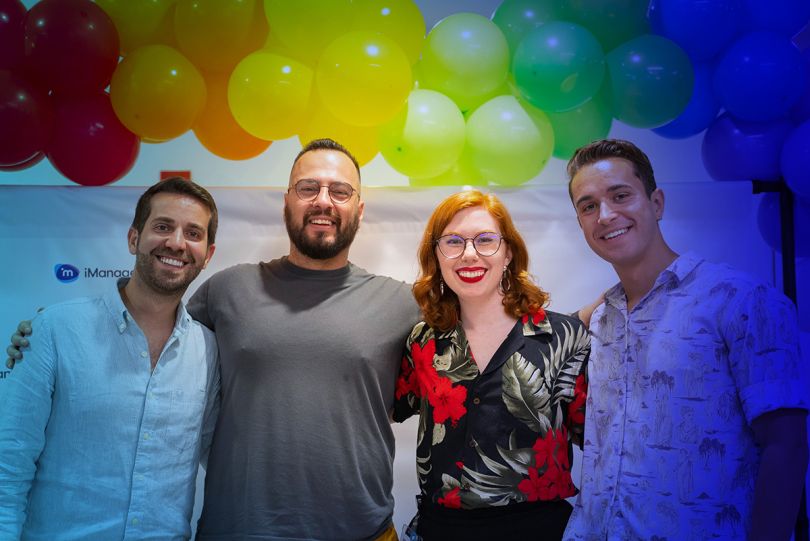A human resources leadership team may have the best of intentions in the implementation of a new ERG: a population of employees to engage and support, a catchy group name with stylish branding, and established communications channels with event ideas outlined.
However, the initiative can still fall flat.
No matter the level of investment or number of internal marketing materials, a top-down approach to ERGs isn’t likely to resonate with employees. But why?
“That’s simple,” said Kelli Ryan, internal communications and engagement manager at iManage. “The most important part of an ERG is the employees, and ERGs are most successful when they are employee-led and initiated.”
It’s not that leadership teams don’t matter — they matter greatly. By empowering employees to lead the charge in developing ERGs, leaders can play important supporting roles such as a liaison, coach or guide, and a connector to resources such as funding.
It’s an approach that’s been successful at Bounteous, explained Angela Zucchero, program manager of culture and DEIB, learning, development and diversity. “Our ERG groups developed as an organic, grassroots effort. They partner with our talent and culture team for coordination and funding, which allows for the groups to be team member-driven yet still have organizational support and backing.”
Ryan, Zucchero and DEI leaders from three more Chicago tech companies outlined some common challenges companies face when establishing ERGs and the best practices that have led their teams to success, including striking the right balance between employee-led development and organizational support.
Partnering with regional banks, the fintech company Chime develops low-cost banking options for customers.
In your experience, what is required to make an ERG program successful?
An ERG program is critical for fostering belonging within an organization and requires intentional thought and design. Start by understanding the needs and expectations of the ERG program. An ERG program should help accomplish goals defined within the organization’s DEI and employee experience strategies. Also be sure to document the process. Map the journey from interest to fully formed ERG to anticipate potential challenges. Employees should understand what is required to start an ERG.
Identify the support system for ERG leaders. This should include an executive sponsor to guide the ERG leaders, a team member within the DEI, human resources or people team to liaise with ERGs, and a dedicated budget for ERG activities and needs. Then, train your ERG leaders. Consider partnering with internal experts to provide training. Investing in your ERG leaders’ development can build a pipeline of future leaders from underrepresented communities. Finally, reward your ERG leaders. These leaders are responsible for a lot, in addition to their full-time roles. Rewarding them shows that the company values its ERG leaders, similar to any other position.
What are some common mistakes when implementing ERGs?
Implementing ERGs is a delicate dance. Company leaders must listen to their ERGs and use their power to eliminate barriers to belonging for community members. Acknowledging that your culture is not conducive to psychological safety for everyone can be hard to hear. Still, it’s only through your partnerships with ERGs that you can create an empowering environment. ERGs stand to make a huge difference when it comes to fostering a culture of diversity, equity and belonging, but they aren’t without their challenges.
Bullock’s common challenges for companies designing ERG programs:
- Assuming every gathering of underrepresented employees needs to be an ERG.
- Building a formal ERG program before you have a critical mass of employees within those communities.
- Asking ERG members to support business goals — diversity recruitment, business development, marketing — without compensation.
- Misinterpreting the need for safe spaces for marginalized employees as signals of division among the workforce.
- Asking for ERG activities to take place only outside of work hours.
- Expecting ERGs to replace hiring a full-time DEI team.
- Assuming ERGs provide value only during their observed heritage month.
How are your team members and related ERGs celebrating Hispanic Heritage Month this year?
Our Latinx ERG at Chime, Chimigos, spearheads our Latinx Heritage Month celebrations for September and October. This year’s theme is “resilience and innovation,” which celebrates the diversity, contribution and power of the Latinx community while facing discrimination, violence and systemic obstacles — most recently with the pandemic. Events will include a daily Latinx history trivia question on Slack, a career development session and a cooking class on Latinx dishes. In addition, Chimigos will partner with our Black ERG, AfroChime, to host a conversation about colorism and the Afro-Latinx experience. Lastly, Chimigos will organize virtual and in-person community volunteer events to support the broader Latinx community.

The AI-powered document and email management software powered by iManage helps businesses extract knowledge and insights from their content to guide business decisions.
In your experience, what is required to make an ERG program successful?
Successful ERGs all share one thing in common: They are made up of passionate individuals looking to build connections with other employees. In order for these grassroots efforts to be successful, organizations need to have a framework in place to partner with budding ERGs for a successful launch and programming. This partnership should empower and enable the ERG to deliver on their goals, while maintaining the group’s autonomy and authenticity.
What are some common mistakes when implementing ERGs?
Companies frequently mistake ERGs as a human resources initiative. While partnership from the people team is absolutely paramount to the success of an ERG, the groups cannot be fabricated or assigned during a planning session. Rather, ERGs should come together organically as empowered employees are given a platform to share their experiences, identity and interests. ERGs should be based on authenticity, supporting all employees to feel welcome, included and seen in the workplace. If establishing an ERG becomes a business goal, or a top-down initiative, the genuine nature of an ERG is lost and the impact becomes less meaningful.
ERGs should come together organically as empowered employees are given a platform to share their experiences, identity and interests.”
Describe a recent event that one of your ERGs spearheaded. What was the occasion, and how did your broader team participate?
iMProud, our LGBTQ+ iMpact Community, recently organized and promoted global events to celebrate Pride Month. The iMProud leadership team spearheaded a month of programming, including happy hours supporting local LGBTQ+ businesses in our global offices, distribution of iMProud swag, sharing history and education around Pride Month and the LGBTQ+ community, and facilitation of a global iMProud trivia event. While the iMProud leadership team planned and endorsed the events, all employees were welcomed and encouraged to participate to learn more about the LGTBQ+ community and how to be a better ally.
ActiveCampaign’s customer experience automation platform helps businesses improve how they reach their customers through email marketing, marketing automation and sales engagement efforts.
In your experience, what is required to make an ERG program successful?
Required is leadership’s commitment to ERGs, recognizing them as invaluable resources to the company. Employees need to step up and lead, and managers need to support the individuals who participate. ERGs help create a culture of trust and belonging through relationships and programming. They drive organizational change and inform where a company is successfully cultivating inclusion and where opportunities to improve exist. But all of this requires commitment — and trust — from all parties involved.
What are some common mistakes when implementing ERGs?
Establishing ERGs but not providing a framework for support is a common mistake. Our DEI team provides the operational structure, coaching and assistance to enable ERG success. That coaching piece, in particular, is a priority. Helping employees build the capacity to serve as a leader not only ensures greater success in ERG implementation but also provides valuable skills to those employees that can be transferred to their full-time roles.
I have also seen ERGs that are established but not provided with any resources, financial or otherwise. ERGs need support in the form of budgets to enable programming and engagement for their communities and allies. They also need resources in the form of logos or other branding tools to ensure visibility.
ERGs need support in the form of budgets to enable programming and engagement for their communities and allies.”
How are your team members and related ERGs celebrating Hispanic Heritage Month this year?
This year, our ActivelyLatinx ERG leaders were inspired by the National Council of Hispanic Employment Program Managers’ theme for Hispanic Heritage Month and chose “unidos: inclusivity for a stronger community” as this month’s core message. With cultivating inclusion and diversity as one of our core values, our ActivelyLatinx ERG partnered with our DEI team to bring forward initiatives intended to uplift and share the diversity of ethnicities and experiences that exist within the Latinx and Hispanic community. Our programming will focus on health and wellness, and will include reflections on what this month means to our ActivelyLatinx community, a professional advancement panel and a culture share and tell.
Smokeball helps small law firms increase productivity, organization and profitability through its legal practice management software.
In your experience, what is required to make an ERG program successful?
Success needs a clear vision, a guiding coalition and backing from all levels of leadership.
If you are unsure why the group exists, it will flounder. Having a goal is great, but if you don’t have clear ideas for how to get there, your members will feel a lack of direction. At Smokeball, we chose to work toward our goals by utilizing four main focuses: partnerships, education, events and hiring. This framework has allowed us to hit the ground running.
Creating a guiding coalition means getting buy-in and participation from people at all levels of the organization who are influencers or are ready to help make change. It is vital to do work behind the scenes to ensure that you’ll have a receptive core group that can back you up and help propel things forward.
Not every leader needs to actively participate in the program, but it is important to ensure they understand the “why” and are ready to support the initiative. This may mean being aware of group meetings or project demands on their direct reports, or in the case of higher-level leaders, being willing to dedicate budget or other resources.
What are some common mistakes when implementing ERGs?
A lack of clarity is a common mistake. If there is no vision or a clear path to goals, you’ll lack direction and drive and teams will quickly become disengaged.
Making things mandatory is another mistake. People move at different paces. Topics in education sessions or discussions about DEI can be challenging. Forcing participation can damage your goals. It can cause people to tune out, be disruptive or create an antagonistic atmosphere. It’s better to trust your guiding coalition to be agents of change. This will help grow participation organically.
Additionally, a lack of leadership support is a mistake. Leadership support comes in many forms. It may be budget allocation, but support is not only financial. Leadership must understand the goals of the initiative and support their direct reports’ participation. This can mean balancing daily work across teams to allow participation or talking about upcoming events during team meetings.
Finally, moving too fast is also common. Be ambitious and courageous with goals, but plan and act strategically. If you try to do too much too quickly, you risk burnout. Each group must decide on their capacity. It’s vital to be honest about the amount of change needed and the road ahead.
Be ambitious and courageous with goals, but plan and act strategically.”
How are your team members and related ERGs celebrating Hispanic Heritage Month this year?
Hispanic Heritage Month is one of the awareness months that we observe at Smokeball. We’ll be holding one of our monthly employee round tables. Our volunteer moderators will come prepared with information and personal stories to get the conversation going. From there, they will help moderate discussions and questions. We also have an awesome newsletter team. The Hispanic Heritage Month issue of our DEI newsletter will include mini articles and experience-sharing pieces, recommendations for books and podcasts, and events happening in Chicagoland. We’ll also be looking to spotlight important information through posts on Slack during the month.

Bounteous collaborates with brands in hospitality, retail, healthcare, manufacturing and other industries to create engaging digital experiences for customers.
In your experience, what is required to make an ERG program successful?
Supporting and amplifying our ERGs has required a strategic recipe. Securing leadership support has helped to create the program’s visibility and awareness. Investing time and money demonstrates to team members that their group is supported. Each group is positioned with our overall company values to ensure they are ingrained into our organizational culture. As a result, our groups are an outlet for expression, connection, change and ultimately a sense of belonging, which is critical to retention and engagement. We acknowledge that our culture has always driven our success, and our culture is generated by our talented team members.
What are some common mistakes when implementing ERGs?
What companies may not appreciate is that the sponsorship from leadership, the visibility within the organization and the policies that support the changes that occur as a result are what perpetuate the legitimacy and authenticity of the ERGs. Some companies may view their ERGs as a nice-to-have or a substitute for active policy choices, and this can be a misstep. This could lead to undue emotional labor for leaders of the groups and team members as they navigate global news, community challenges and personal values.
Understanding that ERGs support not only team members’ needs but also business needs is key. We’ve seen our ERGs impact the way we do business by advocating for change, such as rethinking common insensitive technology nomenclature in our industry, improving app and website accessibility and standardizing pronoun choice options on client web forms. With this, ERGs can mature and graduate to business resource group roles and directly influence company policy, partnerships and business outcomes. We feel that our program is at the forefront as we move in this direction.
Understanding that ERGs support not only team members’ needs but also business needs is key.”
How are your team members and related ERGs celebrating Hispanic Heritage Month this year?
We’re excited to celebrate Hispanic Heritage Month by taking the same approach we take for all cultural commemorative months, featuring educational, awareness-driven, celebratory programming. Our programs encourage advocacy through listening, learning and dialogue.
Our team members will have the opportunity to experience the educational event through a panel program featuring outside guest speakers, a celebratory event with hosted games of Lotería and in-person meetups in partnership with Latinas in Tech. We will consistently raise awareness throughout the month by driving all-company communications of our programming and extra resources on our Bounteous intranet. Team members also share their heritage, recipes and more in our Black, Indigenous and People of Color resource groups’ Slack channel, and allies are invited to listen, learn and ask questions.














